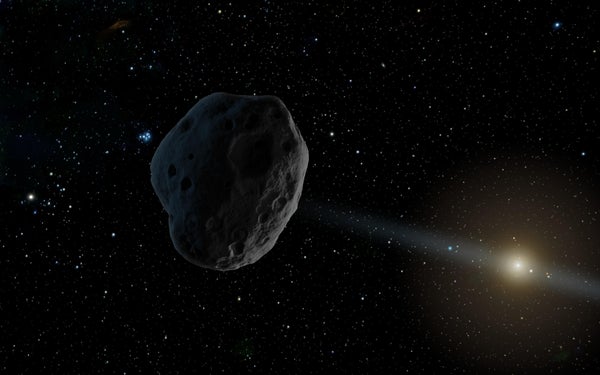September 25, 2024
3 min read
Earth Is Getting a New Mini Moon
A small asteroid, 2024 PT5, will spend the next two months alongside our planet as a mini moon before swooping back to deep space
An artist’s concept of a small asteroid in deep space. When such objects approach within a few million kilometers of Earth moving at sufficiently slow speed with respect to our planet, they can be captured as satellites.
In just a few days, Earth is set to get a mysterious visitor from deep space—but it won’t stay long.
First spied on August 7 by a telescope in South Africa as it swooped within about a half-million kilometers of Earth, the 10-meter-wide object, dubbed 2024 PT5, appears to be a relatively run-of-the-mill asteroid—a member of the sparsely populated “Arjuna” family that trails our planet around the sun. But what it’ll do next is rather special. Just after 4 P.M. EDT on September 29, this small outward-bound space rock will be some 1.5 million kilometers away, traversing the far reaches of our planet’s gravitational grasp. Slowed by that distant pull, it will enter a curving, captive path around our world rather than slipping Earth’s surly bonds. At that point, 2024 PT5 will become another satellite of Earth—a so-called mini moon.
Its sojourn alongside Earth will be brief, however, not even allowing this interplanetary visitor time enough to complete one full orbit. By November 25, the sun’s gravitational tugging will have overcome that of Earth’s, sending this mini moon back into its default heliocentric orbit with the rest of its Arjuna kin.
On supporting science journalism
If you’re enjoying this article, consider supporting our award-winning journalism by subscribing. By purchasing a subscription you are helping to ensure the future of impactful stories about the discoveries and ideas shaping our world today.
There’s no need to grab your backyard telescope to glimpse our temporary guest—this mini moon will, alas, be too small and dim to be seen by such a modest kit. Carlos de la Fuente Marcos, co-discoverer of 2024 PT5 and a mini-moon-studying astronomer at Spain’s Complutense University of Madrid, told Space.com that you’d need a telescope at least 30 inches (76.2 centimeters) in diameter paired with a digital detector to image the object.
If missing out on a telescopic snapshot of a faint fuzzy dot somehow leaves you feeling blue, there’s solace to be found in the future. Based on 122 measurements of its orbit across 21 days, 2024 PT5 is predicted to be transiently captured by Earth again in 2055, offering three decades in which to plan your ideal observations. (Tracing 2024 PT5’s orbit back across the years suggests this object also briefly became a mini moon in 1960, although no one noticed at the time.) But if you’re impatient, don’t fret—mini moons are somewhat common, and some last longer than others.
In the paper reporting 2024 PT5’s discovery, de la Fuente Marcos and his brother, co-author Raúl de la Fuente Marcos, also at Complutense University of Madrid, note that four other mini moons have been confirmed and reported in the scientific literature: 1991 VG, 2022 NX1, 2006 RH120 and 2020 CD3. Dynamically speaking, the first two objects are much like 2024 PT5 in that they’ve been observed briefly loitering in Earth’s clutches only to be swept away before completing a single revolution of our planet. Such “flyby” mini-moon events are thought to crop up several times each decade, albeit most have so far gone undetected by astronomers. The latter two reported mini moons have been of a less frequent, longer-lasting type, lingering as satellites of Earth for at least a year and at least one full orbit around our planet; these “orbiter” varieties are so rare that you could count off a century’s worth of such encounters using only the fingers on two hands.
The orbital similarities between mini moons and our own planet have sparked speculations that some of these objects might be artificial in nature. And indeed, sometimes this is the case: one candidate discovered four years ago, 2020 SO, was eventually removed from the mini-moon list after it was shown to be the cast-off upper stage of a rocket that launched NASA’s interplanetary Surveyor 2 mission in 1966. For a time 1991 VG was also suspected to be a space-age artifact—or even an Earth-surveilling alien probe. But subsequent observations—as well as peer-reviewed analysis by the de la Fuente Marcos brothers—suggest that this particular mini moon has purely natural origins.
Such natural mini moons remain tempting targets for future exploration because their occasional close proximity and low relative velocity make them easily reachable from Earth. Despite being nigh invisible to typical consumer telescopes—or a meager clump of pixels to professional-grade observatories—perhaps someday 2024 PT5 or one of its fellow mini-moon interlopers will be able to be seen by everyone up close, via images beamed back by a visiting spacecraft.

